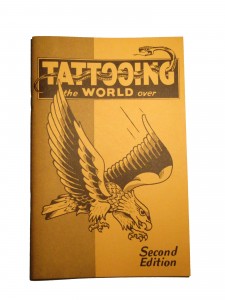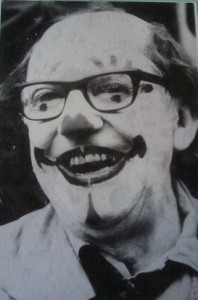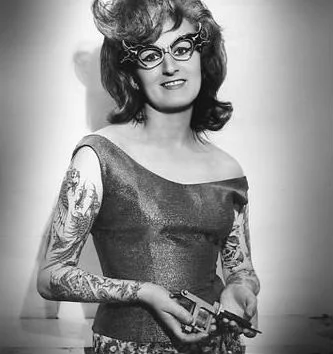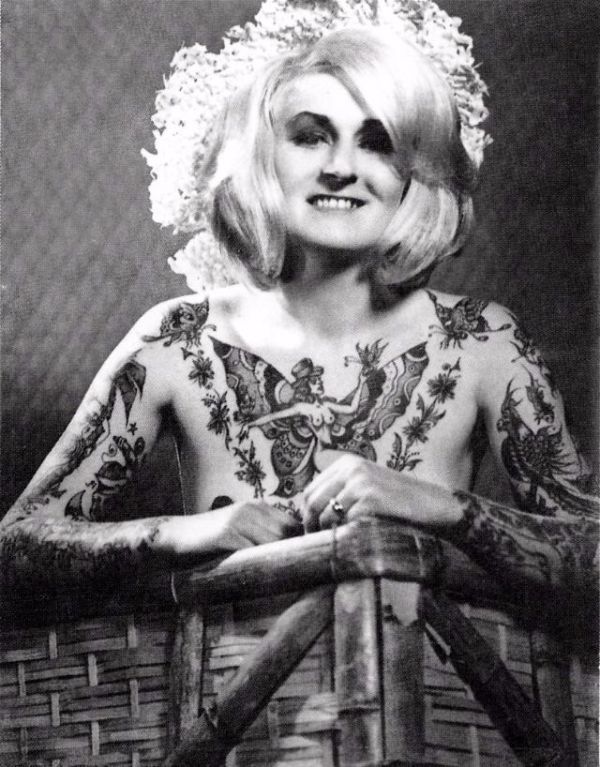Milton Zeis was born in Rock Island, Illinois on December 10, 1901. Starting at a very young age he wanted to live life to the fullest. At 9 years old he set off to see the world and hopped a train West to Calfornia. As a little boy, Milton was fascinated by the circus and it was there he learned of tattooing and magic. It would later prove to be very influential even through the latter parts of his life.
Milton was a jack of many trades and he did quite well with each of them. He was and still continues to be influential to the tattoo community. Milton was very open with his knowledge of tattooing by sharing tips and training others how to tattoo. “The Zeis School of Tattooing” included course work that was sent to students and then sent back to Milton for review. He was also known for his book,”Tattooing the World Over” and tattooing serial numbers on animals.
Before Milton was a full-time tattooer he was a commercial artist. He went to school at the Chicago Art Institute. The Zeis Studio first began as a commercial art studio. He also worked for two publishing companies, Microswitch in Freeport,IL and Rockford Illustrating.
Milton was a great business man and moved to Rockford, IL for a better opportunity. The Zeis studio was a tattoo supply shop that did extremely well. He sold merchandise all over the world through word of mouth and his customer service was great. Milton was very down to earth and treated all men equal.
It wasn’t until the early 60’s on a hot Fourth of July day where he performed at a picnic in his clown outfit. He was the head clown for the Shriners and he went by the name “Uncle Milty”. He enjoyed performing for children and traveled across the country.

Last but certainly not least, Milton was a family man. In 1924, he married Eleanor Gartman and later in 1932, they gave birth to their only child, Joanne. Unfortunately, Eleanor was diagnosed with cancer and passed away on November 19, 1945. Milton always helped out where he could and stayed by her side. Later he married Lorna on July 16,1949. Lorna had one daughter, Mary.
Milton had a very full life. He died at the age of 71, while getting ready to perform magic tricks in Lanark, IL in 1972.
-ZEIS STUDIO.
Tattoo History | Cindy Ray | Atlanta Tattoo Shop
Tattooing, for a very long time, has been a very sealed, underground, essentially male-dominated subculture. And prior to the 1960s, women in tattooing were quite the anomaly. It was almost exclusively military, bikers, and carny folk that got tattooed. It was extremely taboo for women and civilians to be tattooed at all, far less to be heavily tattooed. In this publication of Gate City’s Monthly Tattoo History blog, we’ll take a look at one of the most iconic trail blazers when it comes to lady tattooers and tattooers in general.
Bev “Cindy Ray” Nichols, the classy lassie with the tattooed chassis. Nichols was just the average single mother who stumbled upon an advertisement in her local newspaper for paid models. Looking for ways to support her family, Nichols found herself in contact with eccentric Melbourne photographer Harry Bartram, who would ultimately create the image of “Cindy Ray”.
One could say Bartram used the image of Cindy Ray to his advantage and exploited her, as she would become one of the first and most notable tattooed models in modern tattooing time. He profited off her image, while she would essentially get nothing. Bartram sold pictures of her all over the world through a mail order service that would be extremely successful, but Nichols would reap none of the benefits. While she essentially got tattooed for free, Bartram promised her wealth and notoriety, and she saw none of that while he saw the benefits tenfold, through tattoo publications, books, and the kits he sold.
Aside from being Australia’s first tattooed model, Nichols would go on to be one of the earliest lady tattooers to grace the industry. Bartram would help influence her but Nichols’ decision to start tattooing came on a whim when her partner at the time broke his hands in a bar brawl and she had to fill in for him. Navigating a tattoo shop as a woman in the 60s took a very thick-skinned, determined, and tough woman to hold her own in with a bunch of surly male tattooers.
She worked in a shop in Williamstown, just outside Melbourne, with people passing by and gawking at her like she was a sideshow freak because she was a heavily tattooed woman who tattooed to make a living and survive. The path she took was considered extremely scandalous because tattoos were considered to be so low brow in those days.
Nichols made it through, though, and she would become one of the most famous and influential personalities in the modern history of tattooing. So much so that in 2005 at the Old Tattoo Expo of San Francisco, she was inducted into the Tattoo Hall Of Fame.
Nichols’ story reminds us that tattooing has evolved to see many talented and groundbreaking women pave the way and advance women in tattoo shops and the industry. And as a community, archiving and documenting the lives of those that came before us so that the knowledge is not lost and is passed along to future generations is so important because our heroes won't live forever.-Gate City Tattoo.



